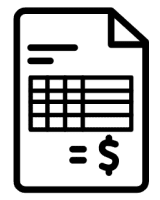Review Your Previous Spending With a Personal Income Statement
To ensure you get the best information, you will find ZERO ads, affiliate links, and sponsored posts on this site. Click here to learn more about my mission.
You’ll specifically use this article in Step 2 of The 9 Steps to Financial Freedom. However, it’s beneficial in all steps.
Find yourself saying, “Where is my money going?!?”
How long has it been since you last reviewed your spending? Last month? Last year? A past life?
Checking in on your previous spending can truly open up your eyes. Expenses that you thought were of no concern, may turn out to be damaging your quest towards financial freedom.
As a financial coach, I have come across many individuals who were paying for things that they did not even need. By eliminating those expenses, they were able to refocus their income on more important financial goals.
A properly structured income statement can help you review spending patterns and determine expenses that can be reduced or even eliminated.
What You’ll Need
Before creating your income statement, you will need to compile the following items:
- Pencil and Personal Income Statement (See Below)
- Most recent pay stubs
- Bank and credit card statements/printouts that show the last 30 days of activity
- Receipts for all cash purchases that you made over the last 30 days
In addition to the above items, you also need everyone that is financially involved in the household to be present. In other words, if you are married, BOTH spouses need to be present.
Go get them!
Categorize Every Expense
Begin by reviewing all of your statements/receipts and categorizing every expense.
If you see “McDonald’s” on your statement, label it dining out. If you see “The Gap”, label it clothing. Get the idea? I know, it’s pretty simple.
Here are some of the major categories that you are going to have:
- Housing
- Utilities
- Food
- Transportation
- Clothing
- Medical
- Personal Items
- Recreation
- Debt Payments
All of these categories will have several sub-categories as well. For example, under transportation you might include your insurance premium, gasoline, loan payment and maintenance.
*IMPORTANT* – When you are looking at your credit card payments, only include the amount in excess of what you charged to the card in the last 30 days. In other words, if you used your Visa to purchase $400 worth of clothing (and that was the only purchase), you already accounted for that $400 in the clothing category. If you made a $500 payment on the Visa, you would include the additional $100 in the debt payments section.
You also do not want to count any money that you moved over to savings. We’ll talk about that later.
Count Your Income
Now that you have all of your expenses categorized, it’s time to count your income.
Look at your bank statements and pay stubs to review the net income that you received over the past 30 days. Your income could include any of the following:
- Wages
- Bonuses
- Tips
- Self-Employment Income
- Rental Income
- Child Support
- Alimony
- Gambling Winnings
- Retirement Distributions
- Tax Refunds
- Interest and Dividends
- FSA Reimbursements
- Etc.
You want to list ALL of your income because you may have based your expenses on it.
*IMPORTANT* – Be sure not to count any transfers from your savings accounts as income.
What’s Your Net Income/Loss?
Now it’s time to see how you did.
Add up all of your income and then subtract all of your expenses.
If the resulting number is positive, it means that you more than likely had money left over in your checking account, moved some money to savings or made some investments. If it is negative, one of two things happened. You either used savings to cover the deficit or accumulated additional debt.
Fixing Financial Leaks
If your number is negative, not all is lost. You will need to review your spending and see what categories can be cut back.
Start with some of the easy discretionary items such as dining out, clothing, entertainment, etc. Cut back on some of these items first to see if you can get your number into positive territory!
Another goal is to start planning your income and expenses on a monthly basis. By setting a plan, you can tell your money where to go.



